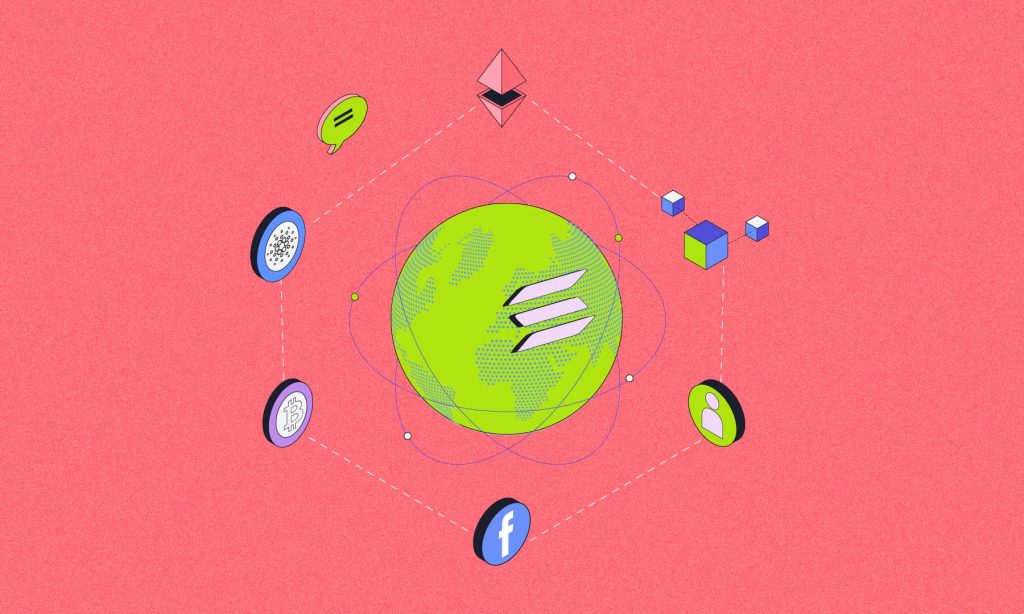We know the internet as a global network of computers with many services. But the World Wide Web is not a static thing. It has seen a lot of evolution over the years, and the third/latest iteration of the internet is now here. As Web 3.0 influences many technological developments, one blockchain network, in particular, is making its presence felt. So here’s a deep dive into the Solana network’s impact on the Web 3.0 ecosystem.
But before we get into any of that, it may help to have a quick recap of the internet’s history.
What is Web 3.0?
To understand the latest version of the internet, let’s start with the beginning with Web 1.0.
Web 1.0 refers to the dinosaur age of the internet. It lasted from the mid-1980s to the early 2000s. It was born when the US Defense Advanced Research Projects Agency (DARPA) began researching protocols. Protocols are essentially algorithm-specified rules computers use to communicate. They create a distributed network called the Internet. HTTP (web), SMTP (email), and FTP (file transfer) are some of the early web protocols.
Then came Web 2.0 in the past twenty years. This version allows regular users to make, share, and publish content. However, it is a read-only web.
Web 3.0 is the next leap forward. It takes us much further by making much more interactivity possible. Unlike previous internet versions that only work with static data, this version has intelligent algorithms. So the services here are more personalized, and computers can interpret data, too. These advances in our web experience are made possible through historical data analysis.
The protocols of the 3.0 version of the internet also prioritize privacy and decentralization. As a user, you can easily control the data. This version is compatible with decentralized applications and smart contracts. So, the internet is democratized in different ways.
The ecosystem began in 2010, and it is expanding to date.
What is Solana?
Solana is a blockchain platform that hosts decentralized applications (dApps). Processing transactions much faster and cheaper than its rival, Ethereum. That makes it a key player in the dApp business. Its native token is SOL.
The Geneva-based Solana Foundation founded the network in 2017.
Now that we know what Solana is let’s assess its role in the Web 3.0 ecosystem.
Four ways that Solana fits in with the Web 3.0 ecosystem
Solana makes a significant impact on the Web 3.0 ecosystem. Here are three developments that should help you understand how.
1. The next Web 3.0 social media will be made on Solana.
On 7 November 2021, SOL’s price peaked at $260. Why did that happen? Because that was the first day of Solana’s Breakpoint 2021 conference. During the conference, Alexis Ohanian, the founder of Seven Seven Six Ventures, announced that his company would create a $50 million fund to develop social media projects on Solana. With the huge funding opportunity, Solana has a good chance of being the next big thing in Web 3.0 social media.
2. Opera partnered with Solana to bring its Web 3.0.
Web 3.0 browser company Opera partnered with Solana in 2021, citing its key features like speed and low transaction fees. Solana’s fast, low-fee transactions will help onboard more people to DeFi and Web 3.0. It is thus going to act like a window into the Web 3.0 space. Further, Opera users can access and benefit from Solana dApps.
3. Solana Ventures launched a $100M Web 3.0 growth fund.
In 2021, Alexis Ohanian also joined forces with Solana Ventures to launch a Web 3.0-focused investment fund. The $100 million fund fosters crypto startups, including social projects.
The bottom line
In this article, we have explored the relationship between Solana and Web 3.0, specifically examining the impact of the former on the latter ecosystem. In addition to everything discussed, the blockchain, a host of various dApps, will lure many more into the Web 3.0 arena. It is better placed than many others to help boost the adoption of the new internet. And the partnerships listed above only strengthen its case.
FAQs
Is Solana a good ecosystem?
Solana was recognized as a blockchain platform with a growing ecosystem and had gained attention for its high throughput and low transaction costs. However, whether Solana is considered a “good” ecosystem can depend on various factors, and it’s essential to consider both the strengths and potential challenges.
What are the benefits of Solana?
It’s important to note that the benefits mentioned here are based on information available up to January 2022, and the cryptocurrency landscape is subject to rapid changes. Before making decisions or assessments, it’s advisable to check the latest information, community discussions, and official communications from the Solana project.
What is the Solana?
Solana is a high-performance blockchain platform designed for decentralized applications (DApps) and cryptocurrencies. It was created to address scalability and speed issues that some blockchain networks face, aiming to provide fast and cost-effective transactions without compromising security.
What technology is used in Solana?
These technologies collectively contribute to Solana’s goal of providing a high-performance blockchain platform capable of handling a large number of transactions quickly and cost-effectively. It’s worth noting that the Solana project continues to evolve, and new features or optimizations may be introduced over time. For the latest and most accurate information, it’s advisable to refer to the official Solana documentation and announcements from the Solana development team.








